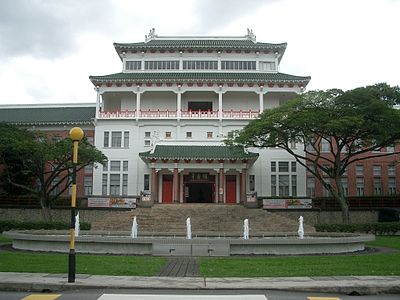- Nanyang University
-
Nanyang University 
Motto People, Progress and Productivity Active 1956–1980 Type Chinese language, Defunct Location Jurong, Singapore 
Campus Urban
500 acres (2 km²)Closed in 1980, assets taken over by the English language National University of Singapore Nanyang University (Chinese: 南洋大学, abbreviated Nantah, 南大) was a university in Singapore from 1956 to 1980. During its existence, it was Singapore's only Chinese language post-secondary institution. In 1980, Nanyang University was merged with the University of Singapore to form the National University of Singapore (NUS).
History
The idea of a Chinese university in Singapore to provide higher education to the Chinese community was first mooted by Tan Lark Sye in 1953, then chairman of the Singapore Hokkien Association. A fund was set up for this purpose, drawing donations from people of all walks of life and with Tan himself donating $5 million. The Singapore Hokkien Association donated 500 acres (2 km²) in the western Jurong area, which was then largely undeveloped rural land.
Nanyang University started classes on March 15, 1956, offering courses in the arts, sciences and commerce. Construction of the entire campus was not completed until two years later. In 1958 the university held its official opening ceremony, officiated by Tan and William Goode, then governor of Singapore.
Nanyang University was merged with the University of Singapore in 1980 to form the National University of Singapore (NUS), in part due to the government's desire to pool the two institutions' resources into a single, stronger entity and promote the English language as Singapore's only main language. The merger was met with strong opposition from the university's alumni in particular, as well as the Chinese community. They considered the university a people's university due to their financial contributions and believed it is a bastion of Chinese education, culture, and social development. They also believed that the merger was a political move by the Singapore government. The promotion of a single education system based on English medium of instruction in pre-tertiary education, however, severely reduced the student catchment pool of Nantah, thus hastening its demise.
With the merger, the Nanyang University grounds was taken over by a new technical institute, the Nanyang Technological Institute (NTI), in 1981. In 1991, the NTI was upgraded to university status as Singapore's second English-medium university, the Nanyang Technological University (NTU). Although technically a distinct institution from the old Nanyang University, NTU has gradually absorbed the rich heritage of the former institution, and there have been calls to rename NTU as Nanyang University to reflect this, particularly with the support of NU's alumni. The administration of NTU has long resisted this move, and the idea receives a lukewarm response from the alumni and current students of the new institution. Most opposition stems from concerns over confusion in the market and the effect it may have on the industry goodwill NTU has cultivated over the years. Some alumni members of NU object to the move, citing the distinction between the two institutions and the need to preserve the heritage of the old university.[1]
The NTU administration finally relented and announced the decision to rename Nanyang Technological University as Nanyang University in 2005, justifying the move based on the university's introduction of non-technology-related schools and its expansion into a full multidisciplinary university. A year before this came into effect, the administration backtracked and postponed the move.[2]
Logo
The three circles in the logo represent values long held to be important in Chinese tradition. They represent a trinity of values: people, progress and productivity. The linking shows the interdependence between the need for people to work together productively and achieve progress. This symbol can now be seen in the National University of Singapore's crest. The circle with the yellow star represents "people," signifying the importance placed on human capital in Singapore.
External links
Categories:- Universities in Singapore
- Defunct universities and colleges
Wikimedia Foundation. 2010.

